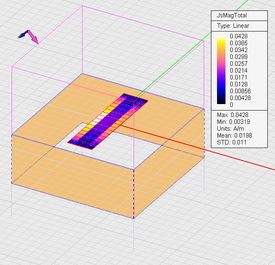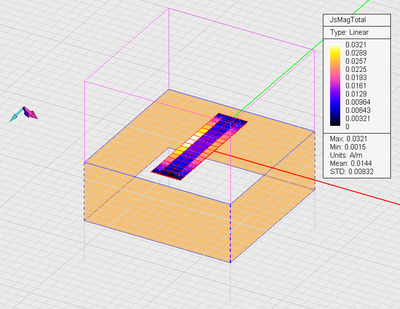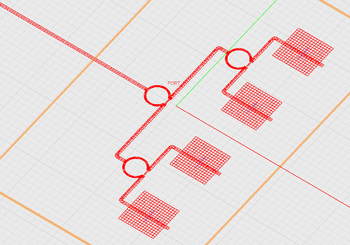EM.Picasso Lesson 5: Modeling Periodic Frequency Selective Surfaces
Contents
Objective:
To construct a periodic planar structure in EM.Cube’s Planar Module, excite it with a plane wave source and compute its reflection and transmission characteristics.
What You Will Learn:
In this tutorial lesson you will use EM.Cube's spectral domain periodic Planar MoM simulation engine and will learn how to define plane wave sources.
Getting Started
Open the EM.Cube application and switch to Planar Module. Start a new project with the following attributes:
- Name: EMPicasso_Lesson_5
- Length Units: mm
- Frequency Units: GHz
- Center Frequency: 9GHz
- Bandwidth: 14GHz
- Number of Finite Substrate Layers: 1
- Top Half-Space: Vacuum
- Middle Layer: ROGER RT/Duroid 5880, εr = 2.2, μr = 1, σ = σm = 0, thickness = 6mm
- Bottom Half-Space: Vacuum
Drawing the Periodic Unit Cell
Define a PEC group called PEC_1 and draw a rectangle strip of dimensions 3mm × 12mm. Open the Periodicity Dialog of the Planar Module by right-clicking on the Periodicity item of the Navigation Tree and selecting Periodicity Settings... from the contextual menu. Check the box labeled Periodic Structure and set the Spacing equal to 15mm along both X and Y directions. Leave the "Offset" boxes with their default zero values.
Defining a Plane Wave Source
Plane wave source are used to illuminate and excite periodic surfaces and compute their reflection and transmission characteristics. To define a plane wave source, right-click on the Plane Waves item of the Navigation Tree and select Insert New Source... from the contextual menu. This opens up the Plane Wave Source dialog. By default, a downward-looking normally incident plane wave source is assumed. This corresponds to incident Theta and Phi angles of 180° and 0°, respectively. Also, the default polarization of plane wave source is "TMz". You can also choose "TEz" or circular polarizations RCPz and LCPz.
| |
In EM.Cube, the incident angles of a plane wave source correspond to its propagation vector. |
For this part of the tutorial lesson, you will start with the default plane wave source and then change its polarization as well as its incident Theta and Phi angles.
Running a Periodic Planar MoM Analysis
Set the planar mesh density to 30 cells per effective wavelength. View and inspect the generated mesh. Also define a default current distribution observable.
| |
If your structure is periodic and excited by a plane wave source, EM.Cube always computes its reflection and transmission coefficients without a need to define an observable. |
Run a quick planar MoM analysis of your periodic planar surface. At the end of the simulation, read the values of the computed reflection and transmission coefficients in the output message window. Also visualize the current distribution on the surface of the strip. Repeat this procedure for the following combination of source polarization and incident Theta and Phi angles:
Running an Adaptive Frequency SweepIn this part of this tutorial lesson, let's run a frequency sweep of your periodic surface to examine its frequency response. But first open the property dialog of the plane wave source and set its polarization to "TEz" with normal incidence, i.e. θs = 180° and φs = 0°. Run an adaptive frequency sweep with the following parameters: Frequency Sweep Type: Adaptive
Start the adaptive frequency sweep simulation and wait until it convergence. You may get a message asking if you want to continue as the required error criterion was not met within the specified maximum number of samples. Let the program continue until converges successfully. Open the Data Manager and plot the data files "REFLECTION_RationalFit.CPX" and "TRANSMISSION_RationalFit.CPX" in EM.Grid. The figures below show the computed reflection and transmission coefficients as a function of frequency for normal plane wave incidence with a TEz polarization.
The Special Case of a Periodic ScreenIn the last part of this tutorial lesson, you will see what happens if you set the length of the strip equal to the Y-period. Open the property dialog of Rect_Strip_1 and set its Y Dimension equal to 15mm. Generate and view the planar mesh of the modified structure. As you can see from the figures below, in this case, the metal strip is considered to be extended to infinity along the Y direction. As a result, an extra row of rectangular cells are placed at the top of the unit cell beyond the periodic boundary to ensure current continuity from this unit cell to the adjacent one.
Keep the TEz polarization and set the incident angles to θs = 180° and φs = 0°. Then run a quick planar MoM analysis of the new periodic planar surface. At the end of the simulation, read the values of the computed reflection and transmission coefficients in the output message window: Reflection Coefficient: -0.516582 + 0.266943j Transmission Coefficient: 0.276652 - 0.765081j
|


















